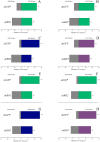Functional Study of Opsin Genes in Pardosa astrigera (Araneae: Lycosidae)
- PMID: 40559024
- PMCID: PMC12193414
- DOI: 10.3390/insects16060595
Functional Study of Opsin Genes in Pardosa astrigera (Araneae: Lycosidae)
Abstract
Spiders are important predatory natural enemies in agricultural and forestry ecosystems, yet the role of vision in their predatory behavior remains unclear. In this study, we screened three opsin genes-corresponding to ultraviolet-sensitive and medium-to-long wavelength-sensitive opsins-from the transcriptome sequencing database of Pardosa astrigera. All three genes possess seven transmembrane topological structures and a lysine residue on the second transmembrane domain, which are typical characteristics of opsins. Using quantitative real-time PCR (RT-qPCR), we analyzed the expression patterns of these opsin genes in different tissues, developmental stages, and under the induction of light at three wavelengths. The results showed that all three opsin genes were significantly expressed in the cephalothorax and expressed across developmental stages with no significant differences. Under light induction, their relative expression first increased and then decreased in both male and female adult spiders. Subsequently, RNA interference (RNAi) was used to individually knock down each opsin gene, confirming their involvement in color vision. These results suggest that the three opsin genes are involved in spider vision, laying the foundation for further elucidating the role of vision in spider predation, and offering a new perspective for reducing the unintended killing of natural enemies by insect traps.
Keywords: Pardosa astrigera; biological control; opsin; phototactic behavior; vision.
Conflict of interest statement
The authors declare no conflicts of interest.
Figures







Similar articles
-
Systemic pharmacological treatments for chronic plaque psoriasis: a network meta-analysis.Cochrane Database Syst Rev. 2021 Apr 19;4(4):CD011535. doi: 10.1002/14651858.CD011535.pub4. Cochrane Database Syst Rev. 2021. Update in: Cochrane Database Syst Rev. 2022 May 23;5:CD011535. doi: 10.1002/14651858.CD011535.pub5. PMID: 33871055 Free PMC article. Updated.
-
Identification, expression analysis, and functional verification of three opsin genes related to the phototactic behaviour of Ostrinia furnacalis.Mol Ecol. 2025 Aug;34(15):e17323. doi: 10.1111/mec.17323. Epub 2024 Mar 20. Mol Ecol. 2025. PMID: 38506493
-
A rapid and systematic review of the clinical effectiveness and cost-effectiveness of topotecan for ovarian cancer.Health Technol Assess. 2001;5(28):1-110. doi: 10.3310/hta5280. Health Technol Assess. 2001. PMID: 11701100
-
Systemic pharmacological treatments for chronic plaque psoriasis: a network meta-analysis.Cochrane Database Syst Rev. 2017 Dec 22;12(12):CD011535. doi: 10.1002/14651858.CD011535.pub2. Cochrane Database Syst Rev. 2017. Update in: Cochrane Database Syst Rev. 2020 Jan 9;1:CD011535. doi: 10.1002/14651858.CD011535.pub3. PMID: 29271481 Free PMC article. Updated.
-
Drugs for preventing postoperative nausea and vomiting in adults after general anaesthesia: a network meta-analysis.Cochrane Database Syst Rev. 2020 Oct 19;10(10):CD012859. doi: 10.1002/14651858.CD012859.pub2. Cochrane Database Syst Rev. 2020. PMID: 33075160 Free PMC article.
References
-
- World Spider Catalog World Spider Catalog. Version 25.0. Natural History Museum Bern. 2025. [(accessed on 21 March 2025)]. Available online: http://wsc.nmbe.ch.
-
- Birkhofer K., Djoudi E.A., Schnerch B., Michalko R. Climatic conditions and functional traits affect spider diets in agricultural and non-agricultural habitats worldwide. Ecography. 2022;2022:e06090. doi: 10.1111/ecog.06090. - DOI
-
- Petráková L., Michalko R., Loverre P., Sentenská L., Korenko S., Pekar S. Intraguild predation among spiders and their effect on the pear psylla during winter. Agric. Ecosyst. Environ. 2016;233:67–74. doi: 10.1016/j.agee.2016.08.008. - DOI
-
- Wyss E., Niggli U., Nentwig W. The impact of spiders on aphid populations in a strip-managed apple orchard. J. Appl. Entomol. 1995;119:473–478. doi: 10.1111/j.1439-0418.1995.tb01320.x. - DOI
LinkOut - more resources
Full Text Sources

